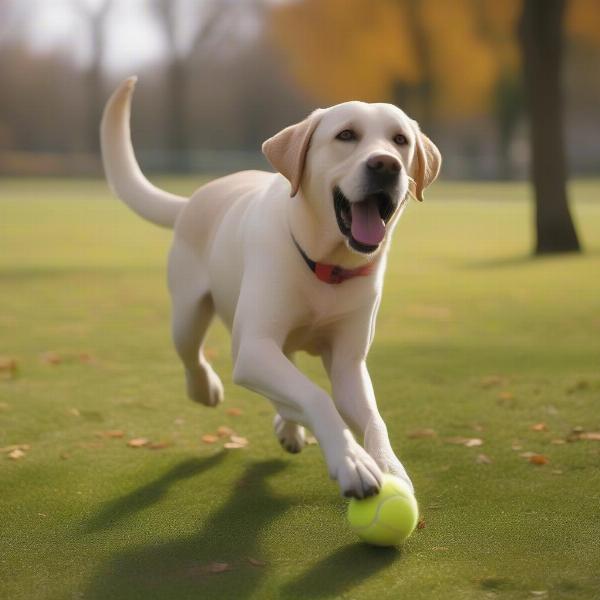Dog balls are a staple in most dog households, providing endless hours of fun and exercise. But with so many options available, how do you choose the right ball for your furry friend? This comprehensive guide will cover everything you need to know about “ball dog” – from selecting the perfect ball to understanding the benefits of play and addressing potential safety concerns.
Choosing the Right Ball for Your Dog
Selecting the right ball depends on various factors, including your dog’s size, breed, chewing habits, and play style. A small ball can be a choking hazard for a large dog, while a large ball might be too cumbersome for a small dog to enjoy.
- Size: Choose a ball that’s appropriately sized for your dog’s mouth. Too small, and it could be swallowed; too large, and it might be difficult to pick up and carry.
- Material: Consider the material’s durability and safety. Natural rubber is a popular choice, as it’s durable and relatively safe. Avoid balls made from brittle plastic that can easily shatter and cause injury.
- Texture: Some dogs prefer smooth balls, while others enjoy textured surfaces that are easier to grip. Experiment to see what your dog prefers.
- Purpose: Are you looking for a ball for fetch, chewing, or interactive play? There are balls designed specifically for each purpose.
The Benefits of Ball Play for Dogs
Playing with balls offers numerous benefits for dogs beyond just fun.
- Physical Exercise: Chasing and retrieving balls provides excellent cardiovascular exercise, helping your dog maintain a healthy weight and burn off excess energy.
- Mental Stimulation: Ball play can challenge your dog mentally, keeping them engaged and preventing boredom.
- Bonding: Playing fetch strengthens the bond between you and your dog, building trust and companionship.
- Training: Ball play can be incorporated into training sessions, reinforcing commands like “fetch,” “drop it,” and “stay.”
 Dog playing fetch
Dog playing fetch
Tennis Ball Dog: A Classic Choice
Tennis balls are a classic choice for dog balls, and for good reason. They’re readily available, affordable, and most dogs love them. However, there are a few things to consider:
- Abrasiveness: The fuzzy exterior of tennis balls can wear down a dog’s teeth over time.
- Size: Standard tennis balls can be a choking hazard for smaller dogs.
- Toxicity: While not highly toxic, some tennis balls contain small amounts of chemicals that can be harmful if ingested in large quantities. tennis ball dog
Alternatives to Tennis Balls
If you’re looking for alternatives to tennis balls, consider these options:
- Rubber Balls: Durable and come in various sizes and textures. tennis ball dog toy
- Rope Balls: Great for tug-of-war and chewing.
- Treat Dispensing Balls: Provide mental stimulation and reward your dog with treats. flashing ball dog
Safety Tips for Ball Play
While ball play is generally safe, it’s essential to take precautions.
- Supervision: Always supervise your dog when they’re playing with balls.
- Inspection: Regularly inspect balls for damage and replace them if necessary.
- Retrieval: Teach your dog to “drop it” to avoid potential tug-of-war injuries.
- Material: Choose balls made from non-toxic materials. puff ball dog
- Size: Ensure the ball is appropriately sized for your dog. tennis ball dog ball
Conclusion
Choosing the right ball and practicing safe play habits can provide your dog with countless hours of enjoyment and contribute to their overall health and well-being. Remember to consider your dog’s individual needs and preferences when selecting a ball and always prioritize their safety.
FAQ
- Are tennis balls safe for dogs? While generally safe, the abrasive surface can wear down teeth, and they can be a choking hazard for smaller breeds.
- What size ball is right for my dog? Choose a ball that is proportionate to your dog’s mouth and that they can easily pick up and carry.
- What are some good alternatives to tennis balls? Rubber balls, rope balls, and treat dispensing balls are all excellent alternatives.
- How can I make ball play more enriching for my dog? Incorporate training commands, use treat dispensing balls, or vary the game by hiding the ball.
- What should I do if my dog swallows a ball? Contact your veterinarian immediately.
- How often should I replace my dog’s balls? Replace them as soon as they show signs of wear and tear.
- Can I play ball with my dog indoors? Yes, but choose a soft ball and be mindful of your surroundings.
Further Reading:
- (Add links to related articles on your website if they exist)
About ILM Dog
ILM Dog is your trusted source for expert advice on dog care and wellbeing. We offer comprehensive resources on breed selection, health, training, nutrition, grooming, and much more. Whether you’re a new dog owner or a seasoned pro, ILM Dog has the information you need to provide the best possible care for your canine companion. We specialize in helping dog owners understand their furry friends better, from choosing the right breed to providing optimal healthcare, training, and nutrition. For any questions or further assistance, reach out to our experts at [email protected] or call us at +44 20-3965-8624.